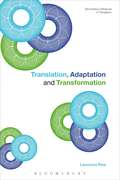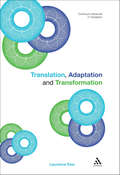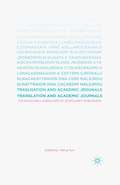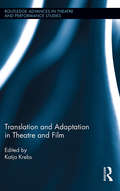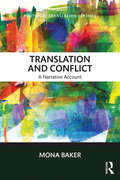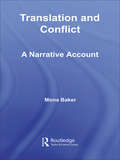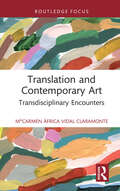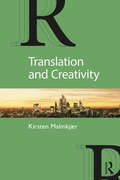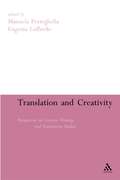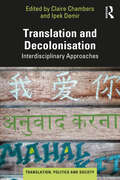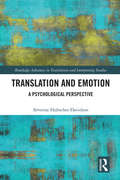- Table View
- List View
Translation: The Interpretive Model
by Marianne LedererThis book, the English version of La traduction aujourd'hui (Hachette 1994), describes the interpretive theory of translation developed at the Paris Ecole Supérieure d'Interprètes et de Traducteurs (ESIT) over the last 35 years. The theory identifies the mental and cognitive processes involved in both oral and written translation: understanding the text, deverbalizing its language, re-expressing sense. For the purposes of translation, languages are a means of transmitting sense, they are not to be translated as such. Although translation involves the use of correspondences, translators generally set up equivalence between text segments. The synecdochic nature of both languages and texts, a phenomenon discussed in the book, explains why translation is possible across language differences. The many practical problems faced by translators, the difference between translation exercises used as a language teaching tool and professional translation, translating into a foreign language, and machine translation as compared to human translation are also discussed.
Translation: The Interpretive Model
by Marianne LedererThis book, the English version of La traduction aujourd'hui (Hachette 1994), describes the interpretive theory of translation developed at the Paris Ecole Supérieure d'Interprètes et de Traducteurs (ESIT) over the last 35 years. The theory identifies the mental and cognitive processes involved in both oral and written translation: understanding the text, deverbalizing its language, re-expressing sense. For the purposes of translation, languages are a means of transmitting sense, they are not to be translated as such. Although translation involves the use of correspondences, translators generally set up equivalence between text segments. The synecdochic nature of both languages and texts, a phenomenon discussed in the book, explains why translation is possible across language differences. The many practical problems faced by translators, the difference between translation exercises used as a language teaching tool and professional translation, translating into a foreign language, and machine translation as compared to human translation are also discussed.
Translation, Adaptation and Digital Media (Translation Practices Explained)
by John Milton Silvia CobeloAdaptation has always been central to Translation Studies, and, as print media becomes less and less dominant, and new media become central to communication, Adaptation is more than ever a vital area of Translation and Translation Studies. In addition, links to new digital media are examined. This is the only user-friendly textbook covering the full area of Translation, Adaptation, and Digital Media applicable to any language combination. Divided into nine chapters, it includes a wide range of texts from Brazilian culture, ensuring an ex-centric view of translation. Each chapter contains an expository section, case studies, and student activities to support learning. It emphasises the central role of Adaptation in the translation of works for the popular book market, for theatre, cinema, radio, and, especially, the new media. This is the essential textbook for students in Translation and Adaptation Studies courses and instructors and professionals working on adaptation and transmedia projects.
Translation, Adaptation and Digital Media (Translation Practices Explained)
by John Milton Silvia CobeloAdaptation has always been central to Translation Studies, and, as print media becomes less and less dominant, and new media become central to communication, Adaptation is more than ever a vital area of Translation and Translation Studies. In addition, links to new digital media are examined. This is the only user-friendly textbook covering the full area of Translation, Adaptation, and Digital Media applicable to any language combination. Divided into nine chapters, it includes a wide range of texts from Brazilian culture, ensuring an ex-centric view of translation. Each chapter contains an expository section, case studies, and student activities to support learning. It emphasises the central role of Adaptation in the translation of works for the popular book market, for theatre, cinema, radio, and, especially, the new media. This is the essential textbook for students in Translation and Adaptation Studies courses and instructors and professionals working on adaptation and transmedia projects.
Translation, Adaptation and Transformation (Continuum Advances in Translation)
by Laurence RawIn recent years adaptation studies has established itself as a discipline in its own right, separate from translation studies. The bulk of its activity to date has been restricted to literature and film departments, focussing on questions of textual transfer and adaptation of text to film. It is however, much more interdisciplinary, and is not simply a case of transferring content from one medium to another. This collection furthers the research into exactly what the act of adaptation involves and whether it differs from other acts of textual rewriting. In addition, the 'cultural turn' in translation studies has prompted many scholars to consider adaptation as a form of inter-semiotic translation. But what does this mean, and how can we best theorize it? What are the semiotic systems that underlie translation and adaptation? Containing theoretical chapters and personal accounts of actual adaptions and translations, this is an original contribution to translation and adaptation studies which will appeal to researchers and graduate students.
Translation, Adaptation and Transformation (Continuum Advances in Translation #8)
by Laurence RawIn recent years adaptation studies has established itself as a discipline in its own right, separate from translation studies. The bulk of its activity to date has been restricted to literature and film departments, focussing on questions of textual transfer and adaptation of text to film. It is however, much more interdisciplinary, and is not simply a case of transferring content from one medium to another. This collection furthers the research into exactly what the act of adaptation involves and whether it differs from other acts of textual rewriting. In addition, the 'cultural turn' in translation studies has prompted many scholars to consider adaptation as a form of inter-semiotic translation. But what does this mean, and how can we best theorize it? What are the semiotic systems that underlie translation and adaptation? Containing theoretical chapters and personal accounts of actual adaptions and translations, this is an original contribution to translation and adaptation studies which will appeal to researchers and graduate students.
Translation after Wittgenstein (Translation Theories Explored)
by Philip WilsonIn this eminently readable study, Philip Wilson explores the later writings of Ludwig Wittgenstein and shows how a reading of this philosophy can enable the translation theorist and the practising translator to reflect upon and improve the phenomenon of translation. Wittgenstein, whilst a key figure in twentieth-century philosophy, remains peripheral to the field of translation studies and Wilson argues that his later work, because it deals with the nature of language and meaning, is potentially of great significance and an awareness of this can change translation, both literary and non-literary. Wittgenstein’s life and thought is treated in the introduction, where it is shown how his methods can be applied to areas outside philosophy. The central three chapters of the book survey: the reading of the source text for translation; the writing of the target text; the theorisation of the target text. The author demonstrates how tools from Wittgenstein’s work can be of use in translation studies: the notion of the language-game, for example, helps us to understand meaning by looking at the way that words are used, and this can both help us describe translation and suggest ways of translating. A wide variety of examples and case studies is given throughout the book, from both literary and non-literary sources. Aimed at translation studies scholars, graduate students and researchers, this interdisciplinary book will also be of interest to scholars of philosophy and literature.
Translation after Wittgenstein (Translation Theories Explored)
by Philip WilsonIn this eminently readable study, Philip Wilson explores the later writings of Ludwig Wittgenstein and shows how a reading of this philosophy can enable the translation theorist and the practising translator to reflect upon and improve the phenomenon of translation. Wittgenstein, whilst a key figure in twentieth-century philosophy, remains peripheral to the field of translation studies and Wilson argues that his later work, because it deals with the nature of language and meaning, is potentially of great significance and an awareness of this can change translation, both literary and non-literary. Wittgenstein’s life and thought is treated in the introduction, where it is shown how his methods can be applied to areas outside philosophy. The central three chapters of the book survey: the reading of the source text for translation; the writing of the target text; the theorisation of the target text. The author demonstrates how tools from Wittgenstein’s work can be of use in translation studies: the notion of the language-game, for example, helps us to understand meaning by looking at the way that words are used, and this can both help us describe translation and suggest ways of translating. A wide variety of examples and case studies is given throughout the book, from both literary and non-literary sources. Aimed at translation studies scholars, graduate students and researchers, this interdisciplinary book will also be of interest to scholars of philosophy and literature.
Translation and Academic Journals: The Evolving Landscape of Scholarly Publishing
by Yifeng SunThis volume comes at a time of rapid expansion in the discipline of Translation Studies and the growth of related journals. Experts and editors of leading journals in the field probe the interactive relationship between the production of journals and the development of Translation Studies and provide a contextual framework for evaluating the field.
Translation and Adaptation in Theatre and Film (Routledge Advances in Theatre & Performance Studies)
by Katja KrebsThis book provides a pioneering and provocative exploration of the rich synergies between adaptation studies and translation studies and is the first genuine attempt to discuss the rather loose usage of the concepts of translation and adaptation in terms of theatre and film. At the heart of this collection is the proposition that translation studies and adaptation studies have much to offer each other in practical and theoretical terms and can no longer exist independently from one another. As a result, it generates productive ideas within the contact zone between these two fields of study, both through new theoretical paradigms and detailed case studies. Such closely intertwined areas as translation and adaptation need to encounter each other’s methodologies and perspectives in order to develop ever more rigorous approaches to the study of adaptation and translation phenomena, challenging current assumptions and prejudices in terms of both. The book includes contributions as diverse yet interrelated as Bakhtin’s notion of translation and adaptation, Bollywood adaptations of Shakespeare’s Othello, and an analysis of performance practice, itself arguably an adaptive practice, which uses a variety of languages from English and Greek to British and International Sign-Language. As translation and adaptation practices are an integral part of global cultural and political activities and agendas, it is ever more important to study such occurrences of rewriting and reshaping. By exploring and investigating interdisciplinary and cross-cultural perspectives and approaches, this volume investigates the impact such occurrences of rewriting have on the constructions and experiences of cultures while at the same time developing a rigorous methodological framework which will form the basis of future scholarship on performance and film, translation and adaptation.
Translation and Adaptation in Theatre and Film (Routledge Advances in Theatre & Performance Studies)
by Katja KrebsThis book provides a pioneering and provocative exploration of the rich synergies between adaptation studies and translation studies and is the first genuine attempt to discuss the rather loose usage of the concepts of translation and adaptation in terms of theatre and film. At the heart of this collection is the proposition that translation studies and adaptation studies have much to offer each other in practical and theoretical terms and can no longer exist independently from one another. As a result, it generates productive ideas within the contact zone between these two fields of study, both through new theoretical paradigms and detailed case studies. Such closely intertwined areas as translation and adaptation need to encounter each other’s methodologies and perspectives in order to develop ever more rigorous approaches to the study of adaptation and translation phenomena, challenging current assumptions and prejudices in terms of both. The book includes contributions as diverse yet interrelated as Bakhtin’s notion of translation and adaptation, Bollywood adaptations of Shakespeare’s Othello, and an analysis of performance practice, itself arguably an adaptive practice, which uses a variety of languages from English and Greek to British and International Sign-Language. As translation and adaptation practices are an integral part of global cultural and political activities and agendas, it is ever more important to study such occurrences of rewriting and reshaping. By exploring and investigating interdisciplinary and cross-cultural perspectives and approaches, this volume investigates the impact such occurrences of rewriting have on the constructions and experiences of cultures while at the same time developing a rigorous methodological framework which will form the basis of future scholarship on performance and film, translation and adaptation.
Translation and Big Details: Part-Whole Thinking as Practice and Theory (Routledge Advances in Translation and Interpreting Studies)
by Jeroen VandaeleIn the age of big data, evidence keeps suggesting that small, elusive and infrequent details make all the difference in our appreciation of humanistic texts—film, fiction, and philosophy. This book argues, from a cross-disciplinary perspective, that expertise in humanistic translation is precisely the capacity to capture those details that are bigger than they seem. In humanistic translation, the expert handling of big details usually serves audiences and the original, but mala fide translation also works the details for subtle manipulation and audience deception. A focus on textual detail is therefore characteristic of humanistic translators but also compatible with central claims of the cultural turn in translation studies. This book, written by a scholar and teacher of literary, essayistic, and audiovisual translation, endeavors to articulate a seemingly dual interest—on textual detail and cultural analysis—as a single one. It theorizes connections between micro and macro analysis, between translation as detail and translation as culture, thus hoping to build bridges between humanistic translators and translation scholars. It acknowledges tensions between practice and theory and proposes a way forward: practitioners and scholars share ways of thinking—varieties of "part-whole thinking"—that machines can never acquire.
Translation and Big Details: Part-Whole Thinking as Practice and Theory (Routledge Advances in Translation and Interpreting Studies)
by Jeroen VandaeleIn the age of big data, evidence keeps suggesting that small, elusive and infrequent details make all the difference in our appreciation of humanistic texts—film, fiction, and philosophy. This book argues, from a cross-disciplinary perspective, that expertise in humanistic translation is precisely the capacity to capture those details that are bigger than they seem. In humanistic translation, the expert handling of big details usually serves audiences and the original, but mala fide translation also works the details for subtle manipulation and audience deception. A focus on textual detail is therefore characteristic of humanistic translators but also compatible with central claims of the cultural turn in translation studies. This book, written by a scholar and teacher of literary, essayistic, and audiovisual translation, endeavors to articulate a seemingly dual interest—on textual detail and cultural analysis—as a single one. It theorizes connections between micro and macro analysis, between translation as detail and translation as culture, thus hoping to build bridges between humanistic translators and translation scholars. It acknowledges tensions between practice and theory and proposes a way forward: practitioners and scholars share ways of thinking—varieties of "part-whole thinking"—that machines can never acquire.
Translation and Conflict: A narrative account (Routledge Translation Classics)
by Mona BakerTranslation and Conflict was the first book to demonstrate that translators and interpreters participate in circulating as well as resisting the narratives that create the intellectual and moral environment for violent conflict and social tensions. Drawing on narrative theory and with numerous examples from historical and current contexts of conflict, Mona Baker provides an original and coherent model of analysis that pays equal attention to the circulation of narratives in translation and to questions of dominance and resistance. With a new preface by Sue-Ann Harding, Translation and Conflict is more than ever the essential text for any student or researcher interested in the study of translation and social movements.
Translation and Conflict: A narrative account (Routledge Translation Classics)
by Mona BakerTranslation and Conflict was the first book to demonstrate that translators and interpreters participate in circulating as well as resisting the narratives that create the intellectual and moral environment for violent conflict and social tensions. Drawing on narrative theory and with numerous examples from historical and current contexts of conflict, Mona Baker provides an original and coherent model of analysis that pays equal attention to the circulation of narratives in translation and to questions of dominance and resistance. With a new preface by Sue-Ann Harding, Translation and Conflict is more than ever the essential text for any student or researcher interested in the study of translation and social movements.
Translation and Conflict: A Narrative Account (Routledge Translation Classics Ser.)
by Mona BakerTranslation and Conflict demonstrates that translators and interpreters participate in circulating as well as resisting the narratives that create the intellectual and moral environment for violent conflict. Drawing on narrative theory and using numerous examples from historical and contemporary conflicts, the author provides an original and coherent model of analysis that pays equal attention to micro and macro aspects of the circulation of narratives in translation, to translation and interpreting, and to questions of dominance and resistance. The study is particularly significant at this juncture of history, with the increased interest in the positioning of translators in politically sensitive contexts, the growing concern with translators’ and interpreters’ divided loyalties in settings such as Guantanamo, Iraq, Kosovo, and other arenas of conflict, and the emergence of several activist communities of translators and interpreters with highly politicized agendas of their own, including Babels, Translators for Peace, Tlaxcala and ECOS. Including further reading suggestions at the end of each chapter, Translation and Conflict will be of interest to students of translation, intercultural studies and sociology as well as the reader interested in the study of social and political movements.
Translation and Conflict: A Narrative Account
by Mona BakerTranslation and Conflict demonstrates that translators and interpreters participate in circulating as well as resisting the narratives that create the intellectual and moral environment for violent conflict. Drawing on narrative theory and using numerous examples from historical and contemporary conflicts, the author provides an original and coherent model of analysis that pays equal attention to micro and macro aspects of the circulation of narratives in translation, to translation and interpreting, and to questions of dominance and resistance. The study is particularly significant at this juncture of history, with the increased interest in the positioning of translators in politically sensitive contexts, the growing concern with translators’ and interpreters’ divided loyalties in settings such as Guantanamo, Iraq, Kosovo, and other arenas of conflict, and the emergence of several activist communities of translators and interpreters with highly politicized agendas of their own, including Babels, Translators for Peace, Tlaxcala and ECOS. Including further reading suggestions at the end of each chapter, Translation and Conflict will be of interest to students of translation, intercultural studies and sociology as well as the reader interested in the study of social and political movements.
Translation and Contemporary Art: Transdisciplinary Encounters
by MªCarmen África Vidal ClaramonteThis book looks to expand the definition of translation in line with Susan Bassnett and David Johnston’s notion of the “outward turn,” applying this perspective to contemporary art to broaden the scope of how we understand translation in today’s global multisemiotic world. The volume builds on Bassnett and Johnston’s “outward turn” as well as Edwin Gentzler’s work on “post-translation” which have focused on traversing the disciplinary boundaries of translation. The book takes as its point of departure the idea that texts are comprised of not only words but other semiotic systems and therefore expanding our notions of both language and translation can better equip us to translate stories told via non-traditional means in novel ways. While the “outward turn” has been analyzed in literature, Vidal directs this spotlight to contemporary art, a field which has already engaged in disciplinary connections with Translation Studies. The volume highlights how the unpacking of such connections between disciplines encourages engagement with contemporary social issues, around identity, power, migration, and globalization, and in turn, new ways of thinking and bringing about wider cultural change. This innovative book will be of interest to scholars in translation studies and contemporary art.
Translation and Contemporary Art: Transdisciplinary Encounters
by MªCarmen África Vidal ClaramonteThis book looks to expand the definition of translation in line with Susan Bassnett and David Johnston’s notion of the “outward turn,” applying this perspective to contemporary art to broaden the scope of how we understand translation in today’s global multisemiotic world. The volume builds on Bassnett and Johnston’s “outward turn” as well as Edwin Gentzler’s work on “post-translation” which have focused on traversing the disciplinary boundaries of translation. The book takes as its point of departure the idea that texts are comprised of not only words but other semiotic systems and therefore expanding our notions of both language and translation can better equip us to translate stories told via non-traditional means in novel ways. While the “outward turn” has been analyzed in literature, Vidal directs this spotlight to contemporary art, a field which has already engaged in disciplinary connections with Translation Studies. The volume highlights how the unpacking of such connections between disciplines encourages engagement with contemporary social issues, around identity, power, migration, and globalization, and in turn, new ways of thinking and bringing about wider cultural change. This innovative book will be of interest to scholars in translation studies and contemporary art.
Translation and Creativity
by Kirsten MalmkjærKirsten Malmkjær argues that translating can and should be considered a valuable art form. Examining notions of creativity and their relationship with translation and focusing on how the originality of translation is manifest in texts, the author explores a range of texts and their translations, in order to illustrate original as opposed to derivative translation. With reference to thirty translators’ discourses on their source texts and the author’s own experience of translating a short text, Malmkjær explores the theory of creativity, philosophical aesthetics, the philosophy of language, experimental and theoretical translation studies, and translators’ discourses on their work. Showing the relevance of these varied topics to the study of translating and translations underlines their complexity and the immensity of understanding that is regularly invested in translations. This work proposes a complete rethinking of the concepts of creativity and originality, as applied to translation, and is vital reading for advanced students and researchers in translation studies and comparative literature.
Translation and Creativity
by Kirsten MalmkjærKirsten Malmkjær argues that translating can and should be considered a valuable art form. Examining notions of creativity and their relationship with translation and focusing on how the originality of translation is manifest in texts, the author explores a range of texts and their translations, in order to illustrate original as opposed to derivative translation. With reference to thirty translators’ discourses on their source texts and the author’s own experience of translating a short text, Malmkjær explores the theory of creativity, philosophical aesthetics, the philosophy of language, experimental and theoretical translation studies, and translators’ discourses on their work. Showing the relevance of these varied topics to the study of translating and translations underlines their complexity and the immensity of understanding that is regularly invested in translations. This work proposes a complete rethinking of the concepts of creativity and originality, as applied to translation, and is vital reading for advanced students and researchers in translation studies and comparative literature.
Translation and Creativity: Perspectives on Creative Writing and Translation Studies
by Manuela Perteghella Eugenia LoffredoTranslation and Creativity discusses the links between translation and creative writing from linguistic, cultural, and critical perspectives, through eleven chapters by established academics and practitioners. The relationship between translation and creative writing is brought into focus by theoretical, pedagogical, and practical applications, complemented by language-based illustrative examples. Innovative research and practice areas covered include ideas of self-translation and the 'spaces' of reading, mental 'black boxes' and cognition and the book introduces new concepts of transgeneric translation, pop translation and orthographical translation.
Translation and Decolonisation: Interdisciplinary Approaches (Translation, Politics and Society)
by Claire Chambers Ipek DemirTranslation and Decolonisation: Interdisciplinary Approaches offers compelling explorations of the pivotal role that translation plays in the complex and necessarily incomplete process of decolonisation. In a world where translation has historically been a tool of empire and colonisation, this collection shines the spotlight on the potential for translation to be a driving force in decolonial resistance. The book bridges the divide between translation studies and the decolonial turn in the social sciences and humanities, revealing the ways in which translation can challenge colonial imaginaries, institutions, and practice, and how translation opens up South-to-South conversations. It brings together scholars from diverse disciplines and fields, including sociology, literature, languages, migration, politics, anthropology, and more, offering interdisciplinary approaches and perspectives. By examining both the theoretical and practical aspects of this intersection, the chapters of this agenda-setting collection explore the impact of translation on decolonisation and highlight the need to decolonise translation studies itself. The book illuminates the transformative power of translation in transcending linguistic, cultural, and political boundaries.
Translation and Decolonisation: Interdisciplinary Approaches (Translation, Politics and Society)
by Claire Chambers Ipek DemirTranslation and Decolonisation: Interdisciplinary Approaches offers compelling explorations of the pivotal role that translation plays in the complex and necessarily incomplete process of decolonisation. In a world where translation has historically been a tool of empire and colonisation, this collection shines the spotlight on the potential for translation to be a driving force in decolonial resistance. The book bridges the divide between translation studies and the decolonial turn in the social sciences and humanities, revealing the ways in which translation can challenge colonial imaginaries, institutions, and practice, and how translation opens up South-to-South conversations. It brings together scholars from diverse disciplines and fields, including sociology, literature, languages, migration, politics, anthropology, and more, offering interdisciplinary approaches and perspectives. By examining both the theoretical and practical aspects of this intersection, the chapters of this agenda-setting collection explore the impact of translation on decolonisation and highlight the need to decolonise translation studies itself. The book illuminates the transformative power of translation in transcending linguistic, cultural, and political boundaries.
Translation and Emotion: A Psychological Perspective (Routledge Advances in Translation and Interpreting Studies)
by Séverine Hubscher-DavidsonThis volume tackles one of the most promising and interdisciplinary developments in modern Translation Studies: the psychology of translation. It applies the scientific study of emotion to the study of translation and translators in order to shed light on how emotions can impact decision-making and problem-solving when translating. The book offers a new critical approach to the study of emotion in translation by analysing translators' accounts of their experiences, as well as drawing on a case study of emotional intelligence involving 155 professional translators. The author identifies three distinctive areas where emotions influence translators: emotional material contained in source texts, their own emotions, and the emotions of source and target readers. In order to explore the relevance and influence of emotions in translation, each chapter focuses on a different emotion trait: emotion perception, emotion regulation, and emotion expression.


